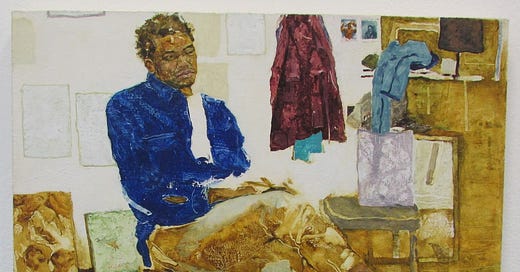I am drawn increasingly to places where sadness has power. The way this face has power, because it is here in this place before us but also suggesting the sitter himself is not here, not really, and thus identifiable as the face that belongs to Eric when his thoughts are someplace else. Thus, when we look at this painting, we can only notice what he does not. For instance, Jennifer Packer’s paintings strewn about the room in which he sits, some turned away from us, some facing us as he does. Lost in translation. One of them an earlier version of this painting in which we can see the body of a single woman in a bath, a clean cut through her head made by the top of canvas, an act of violence interrupting the expression of a face that is depicted otherwise tenderly, and in some way perhaps not wholly unlike the way this painting depicts an earlier version of Eric, one he has presumably long since left behind.
Looking longer, I can’t help but notice a dull blue postcard in the upper right corner of the painting, a blue different than the deeper blue of his jacket, placed somewhere between a red coat and a brown piece of furniture from which many faces look out at us, some that notice us, some that do not, and on top of which an article of clothing (a blue of a different hue) is strewn, how this postcard looks like a blue period Picasso, a portrait of woman I remember, who just like Eric is here and not here, with a look that does not meet that of the one who paints her. Perhaps she can see what he does not see, tracks the important decisions made by light. The way the painter has placed him at the center of the painting only for light to begin to erase him. But I wonder too if that is just a sign of Eric’s mind taking him to places other than this one, perhaps to the days of childhood in which it did not matter if, like my daughter chooses to do, you wore mismatched socks, one brown, the other purple, days where we learned to make hours out of our hands. There is a mark beneath his eye on the left side of his face almost like a tear. A tear that is not a tear but a trick of light, as a lighter shade of brown is placed against a darker one, and is but one small spot of brown in a painting that is filled with other versions of the color. I wonder if this spot of brown is akin to the meaning of blue in those old Picasso paintings, blue which is everywhere and in everything and yet here there is no water but the holiness of thirst.
Discussion about this post
No posts




